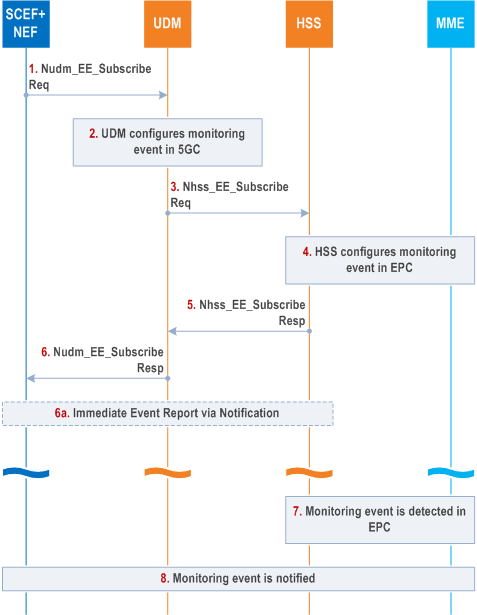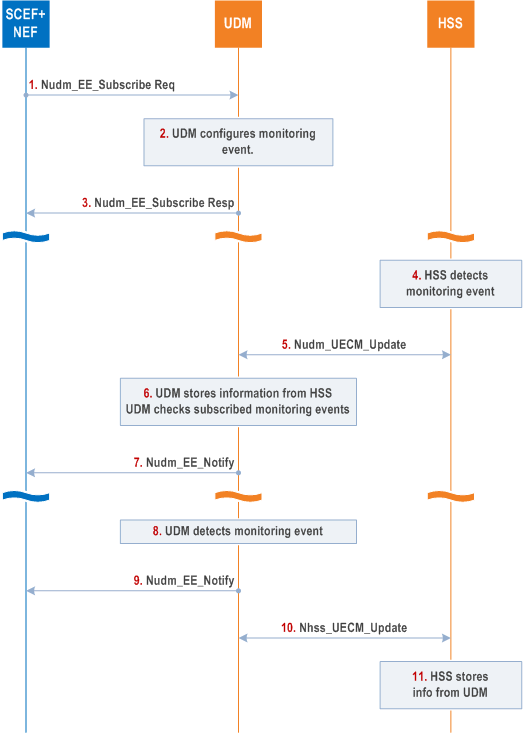Content for TS 23.632 Word version: 18.4.0
5.6 Common Network Exposure Scenarios
5.6.1 General
5.6.2 Configuration of Monitoring Events in MME
5.6.3 Synchronization of Status of Monitoring Event between HSS and UDM
5.6 Common Network Exposure Scenarios p. 41
5.6.1 General p. 41
As specified in TS 23.501 and TS 23.502, a combined SCEF+NEF can configure monitoring events applicable to both EPC and 5GC using only 5GC procedures towards UDM. In this case, the SCEF+NEF indicates that the monitoring event is also applicable to EPC together with the SCEF identity, i.e. the event must be reported both by 5GC and EPC.
If the HSS and UDM are deployed as separate network entities as defined in this specification, UDM uses HSS services to configure the monitoring event in EPC. For events requiring reporting from MME towards SCEF or HSS, the UDM requests the configuration of the monitoring event in the EPC to the HSS as defined in clause 5.6.2.
Common exposure scenarios are applicable for users having both EPC and 5GC subscription.
The status of specific monitoring events that are detected locally at the HSS and UDM (e.g. IMEI/PEI change, roaming status change) is kept synchronized between UDM and HSS as defined in clause 5.6.3 avoiding the need to configure those events in UDM and HSS.
5.6.2 Configuration of Monitoring Events in MME p. 42
Figure 5.6.2-1 shows the scenario where the UDM receives a request from a combined SCEF+NEF to configure a monitoring event that needs to be reported by EPC (e.g. location change).

Step 1.
The UDM receives a request from a combined SCEF+NEF to configure a monitoring event for a UE or for a group of UEs. The request indicates that the subscription applies also to EPC and the monitoring event is to be reported by the MME (e.g. location change). The request includes the notification addresses of both the NEF and the SCEF.
Step 2.
The UDM configures the monitoring event for the UE or for the group of UEs in 5GC. If the 5GS UDR is used, the UDM stores the configuration of the monitoring event for the UE in the 5GS-UDR. The UDM contacts the corresponding NF within the 5GC (e.g. AMF, SMF) as required by the monitoring event.
Step 3.
Unless the subscription information related to the UE or to the group of UEs indicates that the UE or the group of UEs has no EPC subscription data, then the UDM requests the HSS to configure the monitoring event for the UE or for the group of UEs in EPC using a Nhss_EventExposure_Subscribe operation. In addition to the UDM notification address, the UDM provides the SCEF notification address (i.e. SCEF Id).
Step 4.
The HSS configures the monitoring event for the UE or for the group of UEs in EPC using the procedures defined in TS 23.682.
Step 5.
The HSS replies to the UDM with the result of the subscription request.
If immediate reporting was required and the current event status is available at HSS (or received from MME in step 4) and if both the UDM and the HSS support to include event reports in the subscription response, the HSS also includes the current event status in the subscription response to UDM and step 6a is skipped.
If immediate reporting was required but the current event status is not available at HSS (and not received from MME in step 4), the HSS includes a flag in the subscription response indicating that immediate event report is not available.
Step 6.
The UDM replies to the combined SCEF+NEF including confirmation that the subscription was also successful in EPC domain.
Step 6a.
(Conditional) If immediate reporting was required and the current event status is available at HSS (or received from MME in step 4) but the UDM and/or the HSS cannot support to include event reports in the subscription response, the HSS sends a notification including the current event status for immediate reporting, to the UDM using the Nhss_EE_Notify service operation. The UDM then notifies NEF using the Nudm_EE_Notify service operation.
Step 7.
At a later stage, the monitoring event is detected for the UE or for the group of UEs in the EPC domain. The event may be detected at the MME (e.g. location change) or at the HSS (e.g. UE reachability for SMS).
Step 8.
The monitoring event is reported to the SCEF+NEF. The MME notifies the event as defined in TS 23.682 by using the SCEF notification address provided by the HSS in step 4, if applicable. If the monitoring event is detected at the HSS or reported by the MME to the HSS, the HSS notifies the monitoring event to UDM using the Nhss_EE_Notify service operation. The UDM then notifies NEF using the Nudm_EE_Notify service operation.
5.6.3 Synchronization of Status of Monitoring Event between HSS and UDM p. 43
The status of some specific monitoring events that are detected locally at the HSS and UDM (e.g. IMEI(SV)/PEI change, roaming status change) is kept synchronized between UDM and HSS as defined in this clause. This is, when the HSS detects e.g. that the IMEI(SV) for a UE changes (e.g. during an Update Location in EPS), the HSS informs the UDM about the IMEI(SV) change which stores the new IMEI(SV)/PEI accordingly and when UDM detects e.g. that the IMEI(SV)/PEI for a UE changes (e.g. during an AMF registration procedure in 5GC), the UDM informs HSS about the IMEI(SV)/PEI change as described in clause 5.4.6.
HSS and UDM can store the last IMEI(SV)/PEI and Roaming Status even when the UE is not currently located/registered in EPS or 5GC access respectively. If the UE has never registered in 5GC and last PEI is not stored, UDM shall notify HSS about the new PEI received and retrieve the last IMEI stored in HSS to notify the change of PEI/IMEI event when applicable.
This allows that the subscriptions to these specific monitoring events are applied in both domains when the PEI type is IMEI(SV). The UDM is capable of notifying these events taking place in EPS to the combined SCEF+NEF using SBI procedures.
Figure 5.6.3-1 shows the scenario where the UDM receives a request from a combined SCEF+NEF to subscribe to a monitoring event in 5GC and EPC that is reported by the UDM.

Step 1.
The UDM receives a request from a combined SCEF+NEF to configure a monitoring event for a UE. The request indicates that the subscription applies also to EPC (e.g. IMEI(SV)/PEI change) and UDM is expected to report the event.
Step 2.
The UDM stores in the 5GS-UDR the monitoring event together with the notification address (e.g., the NEF notification address) of the combined SCEF+NEF.
Step 3.
The UDM replies to the combined SCEF+NEF including a confirmation that the configuration of the event was also successful in EPC domain.
Step 4.
At a later stage, the HSS detects the event (e.g. IMEI(SV) change) for the UE in the EPC domain (e.g. during an Update Location Request procedure).
Step 5.
The HSS synchronizes with the UDM about the event using the Nudm_UECM_Update service operation.
Step 6.
The UDM stores the information received from HSS (e.g. a new PEI for the UE) in the 5GS-UDR and checks if a related subscription to the related monitoring event exists.
Step 7.
The UDM notifies the NEF accordingly.
Step 8.
Alternatively, the monitoring event may be detected by the UDM.
Step 9.
The UDM notifies the NEF accordingly.
Step 10.
The UDM synchronizes with the HSS about the event using the Nhss_UECM_Update service operation.
Step 11.
The HSS stores the status of the monitoring event received from the UDM in the EPS-UDR.